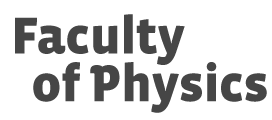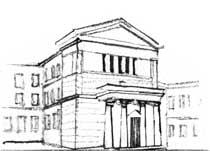"Theory of Duality" (KMMF) Seminar
2006/2007 | 2007/2008 | 2008/2009 | 2009/2010 | 2010/2011 | 2011/2012 | 2012/2013 | 2013/2014 | 2014/2015 | 2015/2016 | 2016/2017 | 2017/2018 | 2018/2019 | 2019/2020 | 2020/2021 | 2021/2022 | 2022/2023 | 2023/2024 | 2024/2025 | Seminar homepage
2025-11-20 (Thursday)
Paweł Strzelecki (MIMUW)
Regularność i osobliwości równań eliptycznych z krytyczną nieliniowością: przekształcenia harmoniczne i nie tylko
Przedstawię przeglądowy wykład na temat regularności rozwiązań układównieliniowych równań eliptycznych, takich jak równania powierzchni ozadanej średniej krzywiźnie lub odwzorowania harmoniczne in-harmoniczne w zwarte rozmaitości riemannowskie. Powiem trochę ohistorii problemu i omówię znane wyniki, od artykułów Richarda Schoenai Karen Uhlenbeck, które ukazały się 40+ lat temu, poprzez prace F.Heleina na temat odwzorowań harmonicznych na płaszczyźnie (jeden zwykładów ICM'1998), aż po najnowsze wyniki A. Schikorry i moichmłodych współpracowników, M. Miśkiewicza i B. Petraszczuka.Przedstawię również nowy, właśnie opublikowany przykład, autorstwaPetraszczuka, który udowodnił, że pewien konkretny, stosunkowo prostyukład dwóch równań eliptycznych na płaszczyźnie (z kwadratowąnieliniowością) - rozważany już przez Jensa Frehsego w 1973 r. - manastępującą zaskakującą własność: dla dowolnego zbioru zwartego K wdysku istnieje ograniczone słabe rozwiązanie o pochodnych całkowalnychz kwadratem, które jest nieciągłe w każdym (!) punkcie K, a gładkiewszędzie poza K. Co ciekawe, to rozwiązanie jest dane konkretnymwzorem, jako granica pewnego ciągu funkcyjnego; N-ty wyraz tego ciąguto rozwiązanie, które ma N punktowych osobliwości w zadanych punktachzbioru K.Na koniec przedstawię kilka pytań otwartych. Postaram się, żeby wykładbył przystępny dla słuchaczy ze stosunkowo niewielkim przygotowaniemmatematycznym.







